
Landmarks
El Cajon Boulevard has a rich history. In the early 1900s El Cajon Avenue was the main wagon road connecting San Diego to the east county.
In 1937,the El Cajon Boulevard Civic Association hosted The El Cajon Boulevard of Progress Festival to celebrate the acceptance of the street as the terminus of Highway 80. In June of 1953, US 80 was transferred to the present routing of I-8, which was then called Mission Valley Rd.
Route 80 received its historic designation in 2006.
The Boulevard Sign

To fill the void of lost neon signage, the spectacular Boulevard gateway sign was erected in 1989 to return to the glory of neon. City officials and local business leaders saw the sign as a major new landmark which would promote The Boulevard as a destination and encourage further community revitalization efforts. The sign was designed by Simon Andrews from Graphic Solutions. The total cost was $200,000. The sign is maintained by The North Park Landscape Maintenance District and was repainted in 2016. The sign is located on The West End of El Cajon Boulevard, just east of Park Blvd,

From Avenue to Boulevard

In the early 1900s El Cajon Avenue was the main wagon road connecting San Diego to the east county. With the growing popularity of the automobile there was a movement to link local roads to form intercontinental highways. In 1912, interstate highway 80 joined the eastern end of El Cajon Avenue at the San Diego city limits. Highway 80 cut a path from San Diego County to the east coast in the 1920s. Over the years El Cajon Avenue was paved and widened. In 1937 the city council voted to change its name from avenue to boulevard to note its significance as a major thoroughfare. In the 1950s, Highway 80 was transferred to the present routing of I-8.
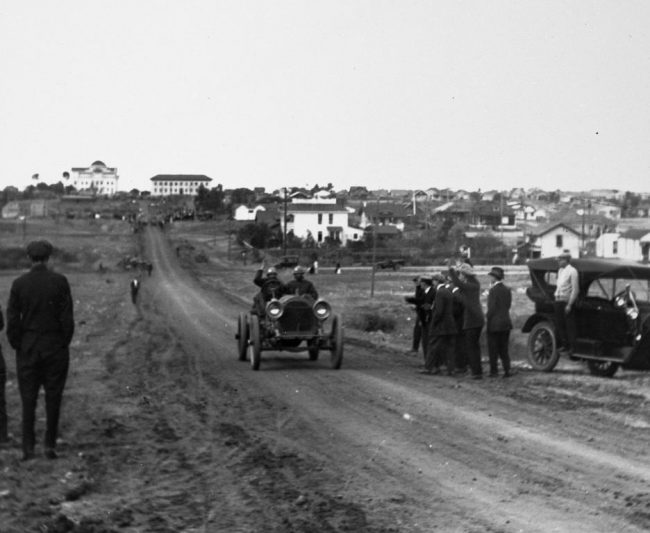
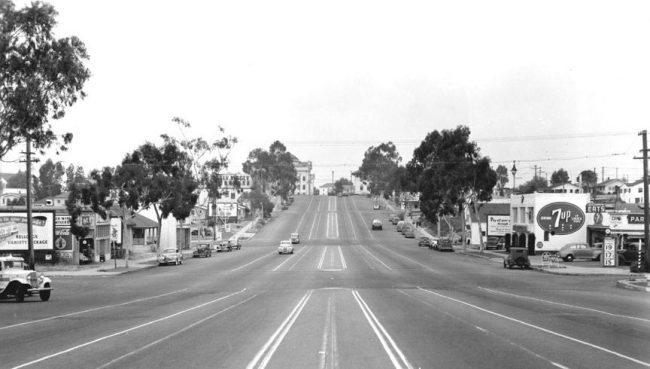
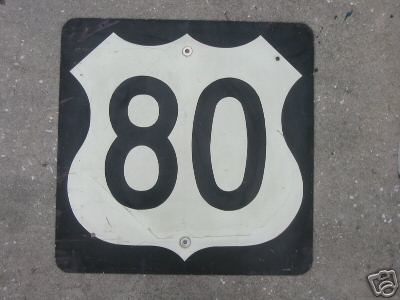
Highway 80 was once referred to as the Broadway of America, a grand transcontinental highway stretching coast to coast, from Tybee Island in Georgia to San Diego, California. No other highway even comes close to being an integral part of so many of the early auto trails. The highway was enjoyed by both travelers and locals a like. Drag races, malt shops, drive-in movie theaters, classic car dealerships, sock hops and other neighborhood amenities shaped the character along El Cajon Boulevard and Highway 80 where car culture was born. However, as the need for ever faster transportation and expansive urban sprawl became apparent, Highway 80 found itself being bypassed as the new interstates took an increasingly larger share of the traffic and business.
The completion of I-8 in 1957 was nearly death of U.S. 80 in California. By 1974, the last official signs were being removed and U.S. 80 technically ceased to exist. Fortunately, in 2006, the State of California designated US 80 a state historic route. With help from County Supervisor Ron Roberts, the El Cajon Boulevard Business Improvement Association has begun to promote cultural tourism along this historic route by installing Historic Highway 80 road signs and banners to encourage drivers to ‘Cruise Historic Highway 80.’ With 30,000 drivers on the road daily, the Boulevard remains one of the most traveled thoroughfares in San Diego.
El Cajon Boulevard, 1970
From a collection created by the City of San Diego Transportation and Storm Water Department from January to October 1970. Described as a Photolog, each reel of 35mm color film was taken by a camera attached to a car driving down the street. The individual reels were converted to a digital version by the City Clerk’s Archives.
El Cajon Boulevard, Eastbound from Park Blvd to the College Area
El Cajon Boulevard, Westbound from 40th Street to Park Blvd
El Cajon Boulevard, The College are to 40th St (The Boulevard starts at 1:25)
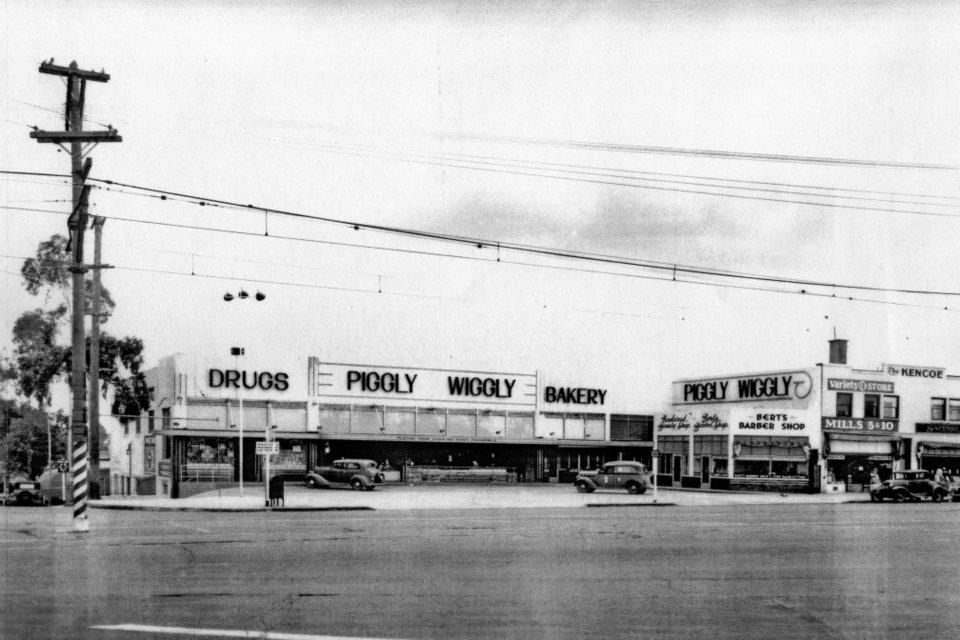
Piggly Wiggly
4237 El Park Blvd
Piggly Wiggly, with their slogan “YOUR HOME TOWN GROCER” was a nationwide chain. Founded in 1916, it was known as the first self-service grocery store in the United States. The first California stores opened in 1923. This location on Park Blvd was built in 1926 and is a great example of Art Deco architecture.
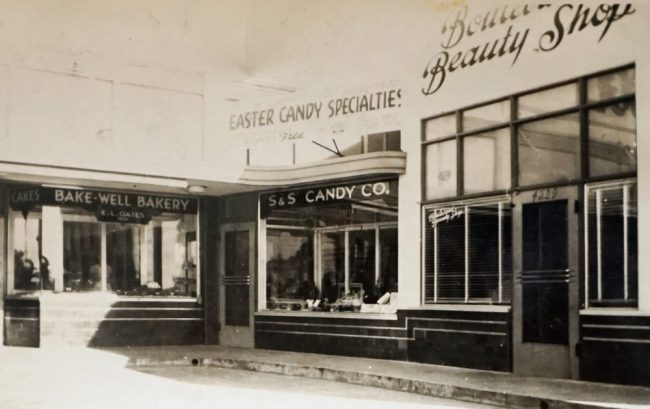
S & S Candy was located in the building starting in 1938. They moved from their 3711 El CAjon Boulevard location (see below).
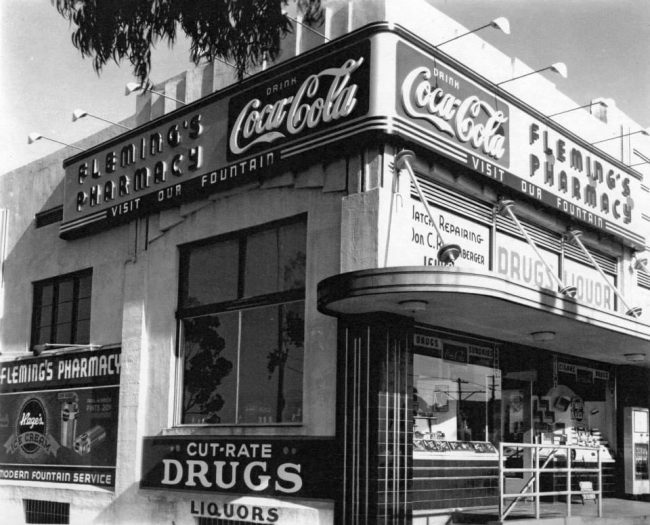
Park and El Cajon Boulevard in 1940
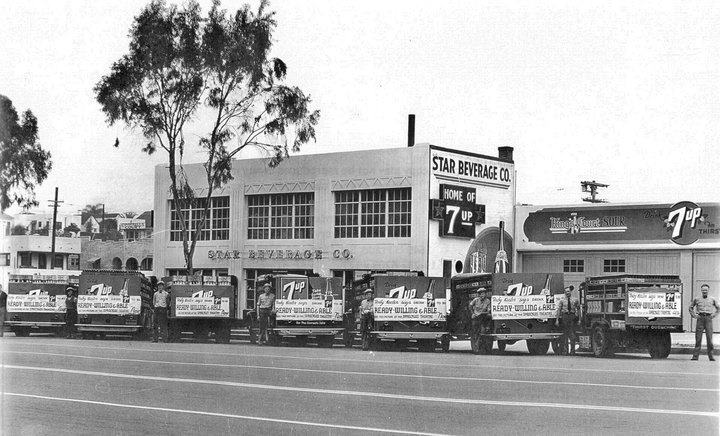
Star Beverages – Home of 7 Up
2010 El Cajon Blvd
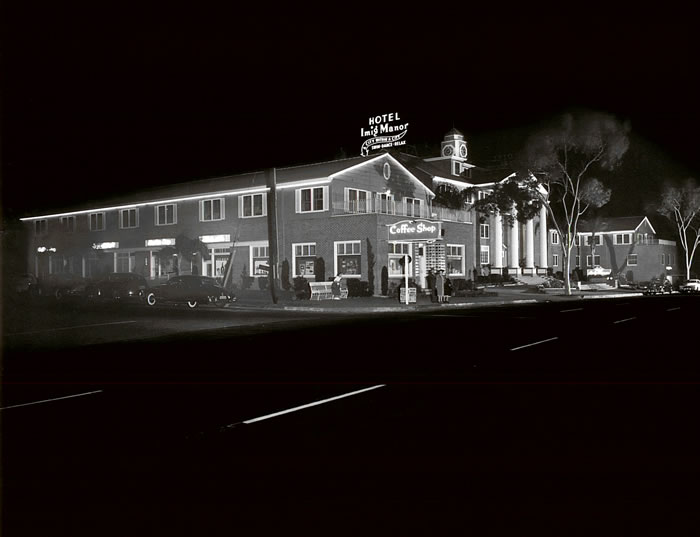
Imig Manor / The Lafayette Hotel
2223 El Cajon Blvd
Built in a grand colonial style in 1946 by former car dealer and developer Larry Imig, this legendary property is rich in history coupled with contemporary style. The Lafayette was born along bustling California Highway 80, the thoroughfare to San Diego fun in the 1940s and 50s. A favorite of the day’s celebrities like Ava Gardner and Bob Hope, this storied hotel became the ultimate playground for the famous, infamous and locals alike. The Lafayette’s well-earned reputation as a legacy vacation resort continues today.

The 1940’s and 50’s – Halcyon Days
In the 1940’s and 50’s, this charming old San Diego hotel inhabited nearly 2.5 acres and boasted 24 shops, 4 restaurants and a nightclub, plus 250 guest rooms, suites, and apartments. In the 1950s, hotelier and San Diego Charger owner Conrad Hilton purchased the San Diego Lafayette and immediately made it his own. Not only did he demolish and relocate several of the property’s apartment buildings and paint the brick façade, but he removed Imig’s large signature from the terrazzo star in the Conservatory floor.
The 1960’s through 2000’s – Vision and Change
The 1960’s ushered in more change as the new Interstate 8 was completed, redirecting traffic away from Highway 80. Sadly, the guests disappeared with the traffic, and The Lafayette’s star began to dim. Ownership changed hands frequently, and the celebrity clientele drifted away. Thankfully, a handful of visionaries saw The Lafayette’s potential and made it their mission to restore the historic San Diego hotel to its former glory.
The 2010’s – A Vibrant Spirit Restored
In 2011, The Lafayette was resurrected. Seeking to uncover the rich spirit of the historic San Diego hotel while respecting its 65-year individuality and easy nonchalance of the neighborhood, developer JCG initiated a complete renovation and restored this legendary hotel’s vibrant soul. With the assistance of the San Diego Redevelopment Agency and the State of California, a much-anticipated 6 million dollar historical renovation was completed. We think even Larry himself would be proud of what we’ve done.
The 2020’s – A Vibrant Spirit Restored
In 2023, the 77 Year Old Lafayette Hotel Reopens after $31 Million Transformation. The historic jewel of The Boulevard, The Lafayette Hotel and Club, has undergone a major renovation by Consortium Holdings. CH Projects, the same group responsible for the incredibly popular restaurants and bars like Morning Glory, Part Time Lover, Born and Raised, and Raised by Wolves purchased the hotel in 2022 and in October they embarked on their biggest and most ambitious project to date. More information, here.
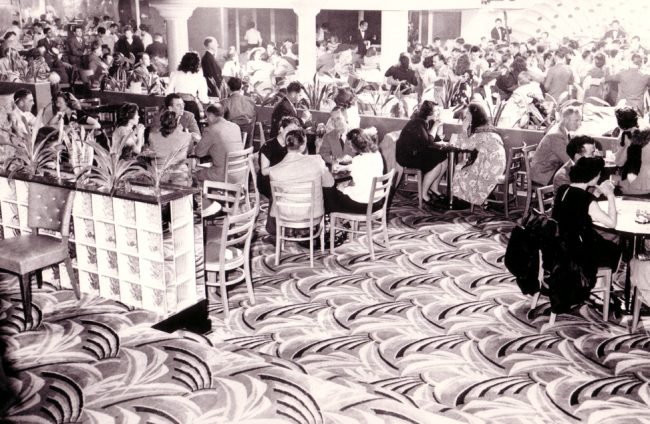

Club ID at the Lafayette
In the 1980’s, the biggest music scene to hit San Diego was at Club ID on El Cajon Boulevard. Trevor Watson and his co-producer Lyn O’Rourke dreamed up the idea of a roving night club and magazine, and it soon became a phenomenon beyond belief.
In seeking out a location, Trevor drove past what is today the Lafayette Hotel, and decided to drop in. During that time, the hotel itself was barely holding on. Trevor recognized it as a place with a great history that lacked luster. Trevor and Lyn approached Frank Sorino, who held a ten year lease on the Mississippi Ballroom with their plan for Club ID. Sorino agreed and offered them their slowest night, Monday. To everyone’s surprise, Monday night was not only the most successful night of the week and Club ID drew more profit than the rest of the week combined.
Trevor Watson was never a DJ, but he knew there was a need for something different. This was before 91X and there wasn’t a single radio station in San Diego playing current 80’s music. The music scene was fairly non-existent, a bit of disco and basic rock and roll, so the two partners decided to shake things up. Week after week Trevor and Lynn invested in records, including rare imports from England. During the era of Club ID, the music transitioned from new wave to house, then onto techno and trance. On special occasions, they brought in outrageous performance artists from LA and bands such as James White & The Blacks and Our Daughter’s Wedding.
Club-goers would save their energy by not going out on the weekend just to party the night away on Mondays. The eclectic diversity of the music was only second to that of the crowd, which is what truly defined Club ID as the first true alternative nightclub in San Diego. There were gays, straights, punks, rude boys, yuppies, new age, new wave, goths, people of all ages, and everyone wanted to get in because Club ID was a place where people’s differences were accepted and they felt special.
Trevor ran fantastic ads in the Reader, which he designed. Club ID also received a lot of publicity during its era, but the biggest means of promotion was their very own magazine, Revolt In Style. It was a bi-weekly publication, which became a popular lifestyle magazine for the San Diego, Los Angeles region. One night Lyn walked around taking pictures of the crowd and they loved it. In the next issue, Revolt In Style published pages of people at Club ID with comic-like captions. Club goers anxiously awaited each publication’s “Pin-Board” in hopes that their picture was featured in the magazine. It was a very successful cross-promotion.
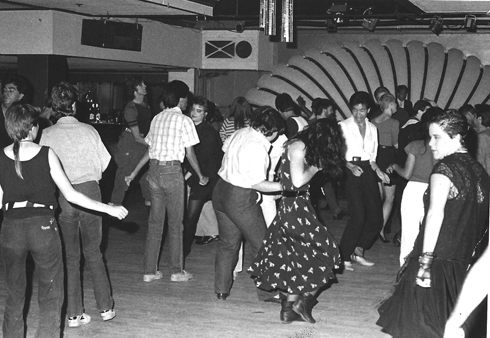
The sensation of Club ID came from doing the right thing, at the right time, in the right venue. The Mississippi Room’s round bar, the clam shell stage and the entire ambience of Club ID is what made people want to be there. In fact, the producer of the movie Top Gun, starring Tom Cruise, attended Club ID, and based on its alluring ambiance decided to shoot the scene ‘She’s Lost that Loving Feeling’.
Unfortunately, with a line of people wrapped around the block every week for two and half years, Sorino’s greed got the best of him. Trevor and Lyn decided to seek out another location for Club ID and the crowd, which became more of an extremely large family, followed-suit.
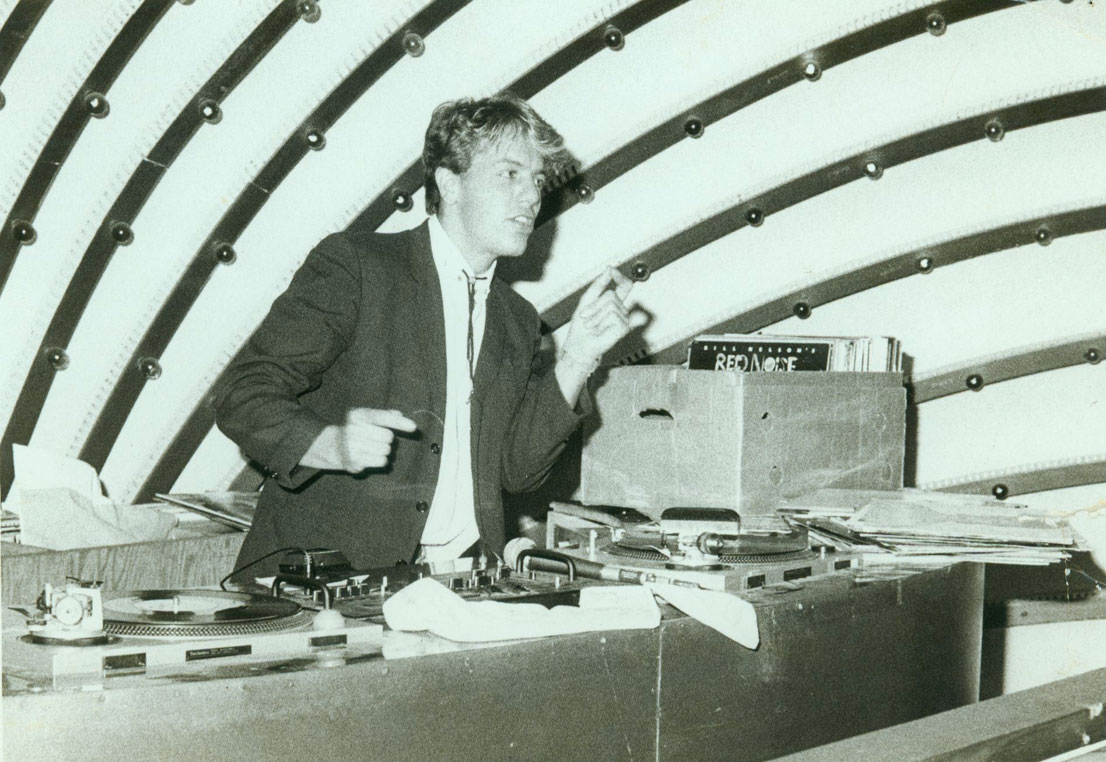
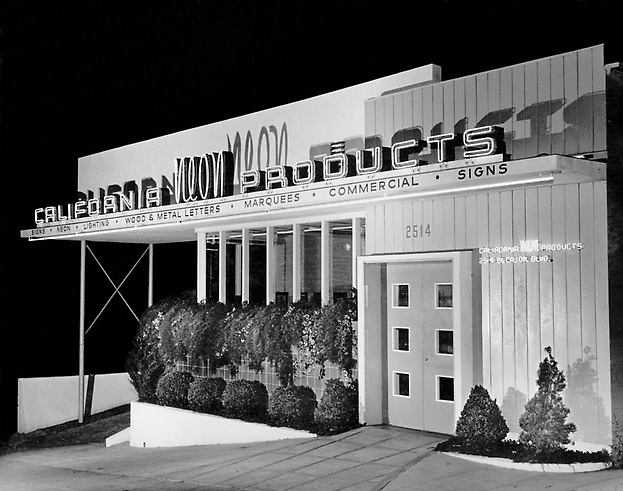
California Neon Projects
2514 El Cajon Boulevard
North Park Water Tower
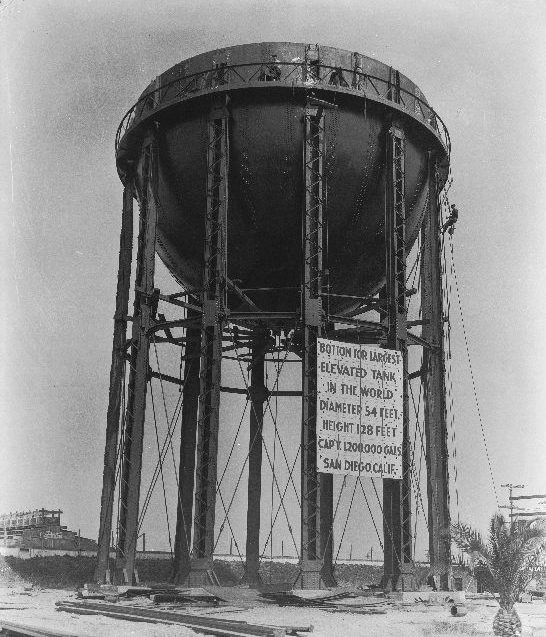
The University Heights Water Storage and Pumping Station on Howard Avenue, which is actually located in North Park, has been listed on the National Register of Historic Places since 2013.
The tank was constructed in 1924 to provide increased water pressure to the surrounding community, which was expanding quickly. It was advertised at “largest elevated tank in the world”. The 127-foot, 5.5-inch tall tower served the community from 1924 to 1967.
The city of San Diego owns the structure, which sits in the center of a still-active city water supply facility. Soccer fields are on top of the reservoirs.
More information, here.

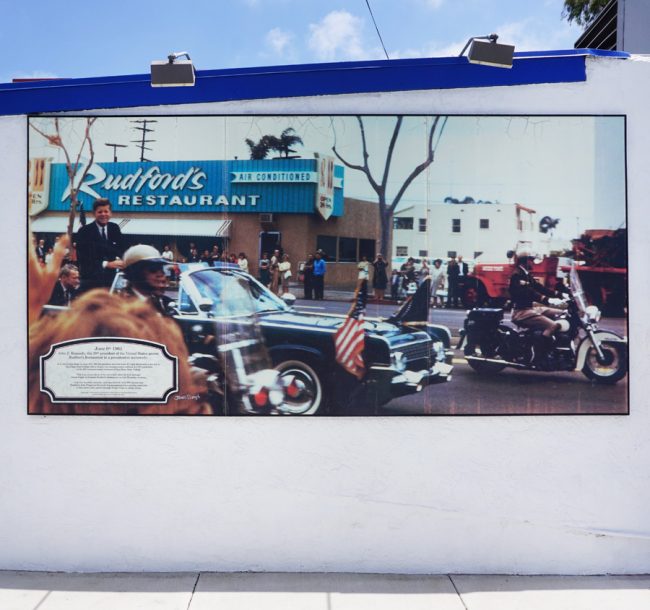
JFK Mural at Rudfords
2900 El Cajon Boulevard
In June of 1963, just months before his assassination, President John F. Kennedy’s motorcade went down El Cajon Boulevard. One of the iconic photos from that day is the president waving at the crowd in front of Rudford’s Restaurant, which has been serving San Diego since 1949.
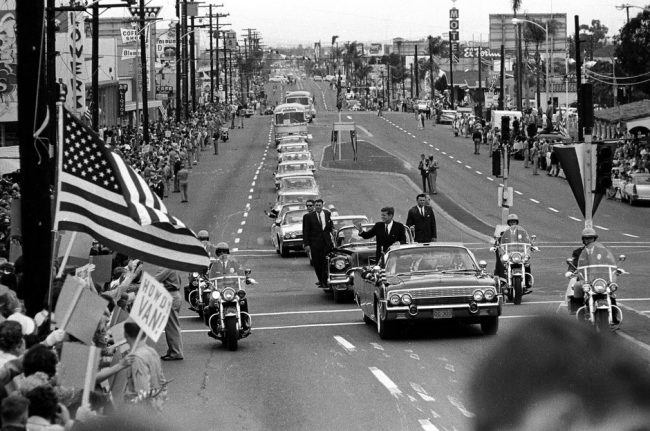
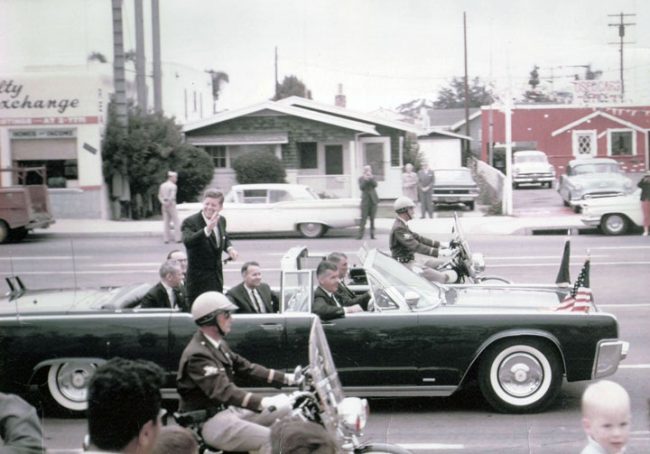

Valjean’s 5 and Dime
2911 El Cajon Boulevard
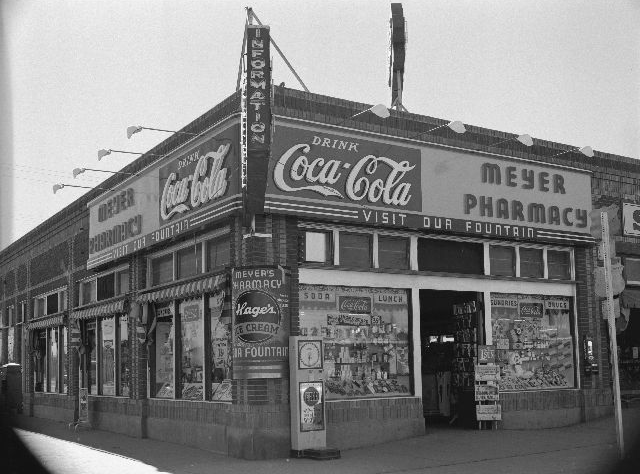
Meyer’s Pharmacy
2947 El Cajon Boulevard
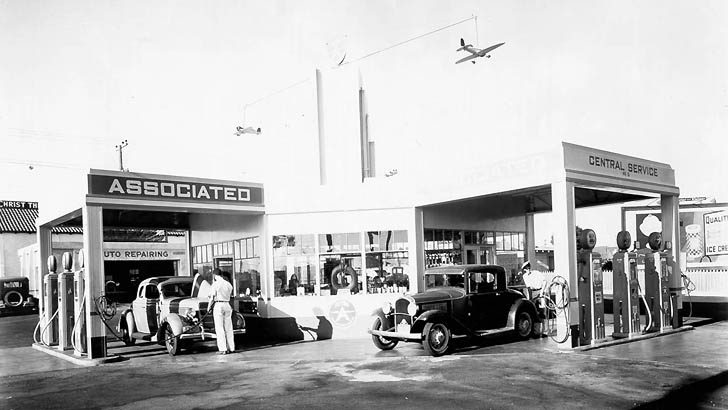
Gas Station
El Cajon Boulevard and 30th St
Step back in time to the days when gasoline was 18 cents per gallon. In a very detailed discussion with Jim Cooley, the late owner of the J. A. Cooley Automotive Museum on 4233 Park Boulevard, it is evident there was a lot more to a gasoline station then simply filling up the tank back then.
Forget self-service, do you remember when the gas station was a one stop shop for all your car needs? Most likely, before the attendant even walked up to your window, your windshields were already cleaned. Then in the process of filling your tank, public service continued. “Please pop you hood sir, would you like me to check your tires?” On the spot, the average gas attendant could recommend an oil change, spark plugs, new tires, or even a new radiator hose.
It paid to go the extra mile because in those days, the gas station included a mechanic shop with a full stock of car parts. Because every car in this country was built in the United States, they were designed with the same parts. Back then local entrepreneurs to owned the gas stations, whereas now the oil industry maintains ownership.
Independent businesses such as Richfeild, Phillips 66, Golden Eagle, Standard Oil, Union 76, and Hancock might ring a bell. This era of independent gas stations revealed a pride of ownership. Not only was full-service an everyday amenity, the bathrooms looked immaculate, the fueling tanks were always clean, and gas station attendants made a point of greeting their customers by name.

Carnation Building
The Carnation building at 3036 El Cajon Boulevard (now home to Lips Restaurant) was photographed in 1965 by famed mid-century architectural photographer Julius Shulman. The KARATE studio that is currently next door cleverly readapted the sign that once read CAMERA.
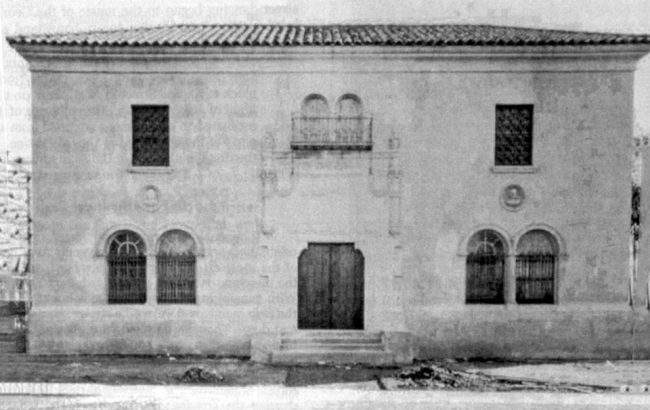
San Diego Gas & Electric Co. Building (SDG&E)
San Diego Gas & Electric Co. Building (SDG&E), Substation F at 3169 El Cajon Boulevard was designed by German-born and New York trained architect Eugene Hoffman in 1926. The Renaissance Revival architecture was by a master architect who designed many other notable structures in San Diego, including the John D. Spreckles building, and William Penn Hotel. The Substation is a rare existing example of early North Park infrastructure which was needed in the development of North Park which was expanding rapidly from the period around 1907 to 1929.

Interstate 805 Completed – 1972
With increased freeway access came many years of disruptive construction and a permanent separation of what was roughly the boundary between San Diego and East San Diego. There was also the loss of many significant historic buildings that were in the path of the interstate.
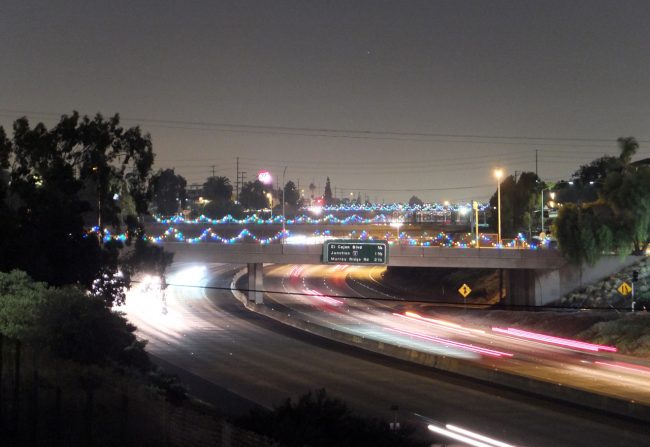
One the bright side, The El Cajon Boulevard Business Improvement Association has overseen the Mid-City holiday bridge lighting project for most of its 30+ year history. The seven bridge light program is a joint effort by the Adams Avenue, El Cajon Boulevard, North Park and City Heights Business Improvement Associations. Initiated in 1988 by the Adams Avenue Business Association, the holiday lighting has inspired similar displays in other locations here in San Diego and attracted attention throughout Southern California.

Keith’s Chicken in the Rough -3200 El Cajon Blvd
Keith’s was a classic drive-in restaurant. One of many that lined The Boulevard. This photo is from 1939. The building was demolished to make way for the 805 freeway.
In the good old days, when a hamburger, fries and milk shakes weren’t the make-up of a fast-food nation, it was all about the Drive-in, not the drive-through. Once drive-ins restaurants opened in the 1930s, new possibilities for dining out captivated the America lifestyle. No longer did one have to dress up to dine out, parents could enjoy eating out with their children, and the art of casual dining immerged. Good food, automobiles converted into tables, and waitresses maneuvering around on roller skates signified a new era of American dining and El Cajon Boulevard was were it was at.
There was Glenn’s, Waikiki, Keith’s, and Oscar’s. Waikiki was the most elaborate with their luau theme. Oscar’s, run by the Peterson family, eventually waved goodbye to their old fashion drive-in restaurant enterprise and became the founders of the fast food chain, Jack n the Box. Keith’s was the longest running drive-in along the Boulevard until the construction of the I-805 freeway in the 1970s.
As fads move in and out, entertainment options evolve. Rising land value, highway development, and fast-food corporations all took their toll on the drive-in restaurant industry.

JFK at 3200 El Cajon Blvd (1963)
As President John F Kennedy’s motorcade made its way down The Boulevard, many San Diegans lined the street to catch a glimpse. In this case Steve Currier captured a section of The Boulevard that would become the 805. Keith’s can be seen in the background, along with United States National Bank.
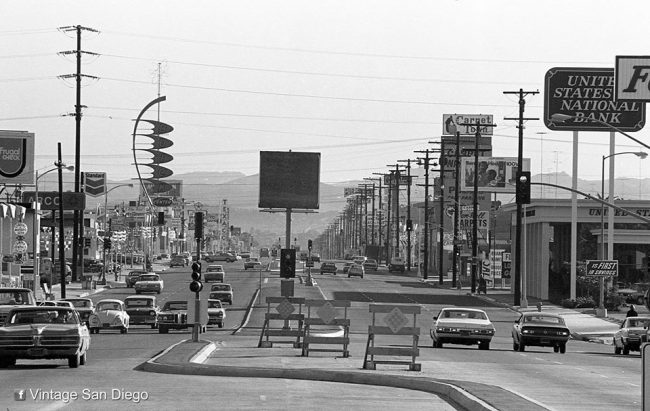
The Boulevard at I-805(1970s)
Here is El Cajon Boulevard looking east from the 805. United States National Bank is now Wells Fargo and a part of the Food Basket sign is where Pancho Villa Market is now located.
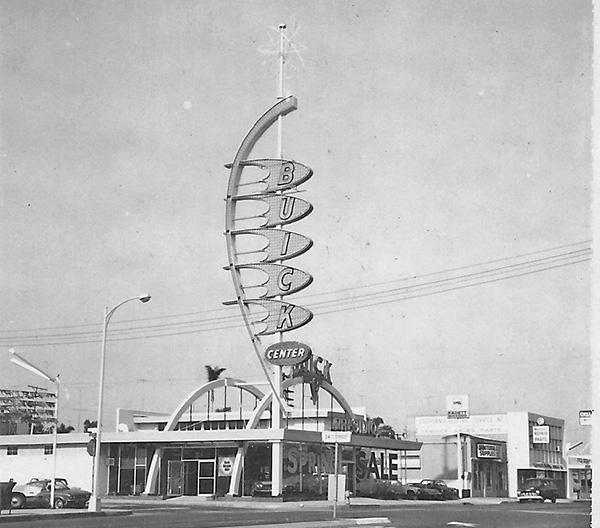
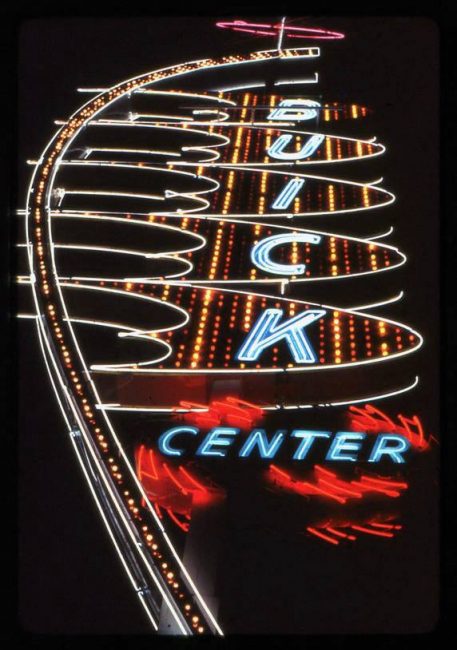
The Changing Boulevard: Buick to Honda
Dick Grihalva Buick Center was located at 3400 El Cajon Boulevard. It had the most blinking neon sign, which can be seen here. In 1953 Joseph Schmith designed the 100-foot-tall sign for the Cal Neon sign company. The sign was lit by neon and thousands of yellow and turquoise bulbs. Schmith also designed the original El Cortez Hotel “Sky Room” sign.
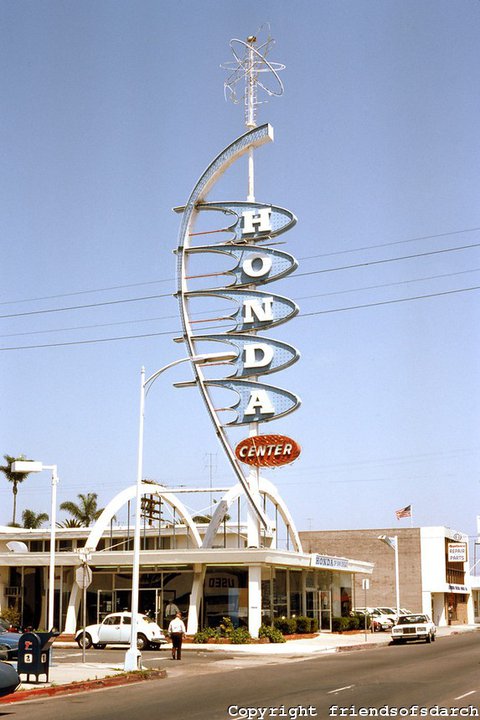
Mike Smith’s Honda (later Mike Smith-Cush Honda) took over the dealership and sign in the 1980s. The sign was demolished sometime in the late 80’s or early 90’s. The Googie arches were also removed. The building is still there.
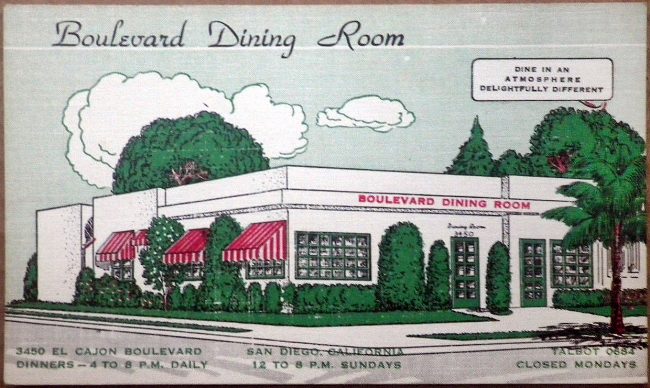
Boulevard Dining Room
3450 El Cajon Boulevard
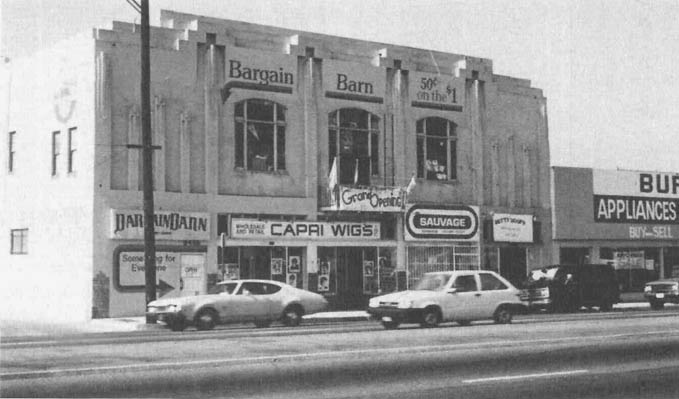
Circle Sound
3465 El Cajon Boulevard
The Rock Palace at Circle Sound
By Bart Mendoza
The area doesn’t look particularly happening today, but 3465 El Cajon Blvd., aka the Rock Palace, was for a brief time during the mid 1980’s a key location for both the mod and punk scenes.
The art deco building itself dates to 1928.* Today there’s a few shops at street level, with three large windows overlooking the area. Peeling paint disguises what was once a vibrant place.
The building sat unused for many years until 1977 when Richard Bowen built a studio on the second floor. Circle Sound Studios quickly became one of the premier recording establishments of the day, with two rooms. The 5,000 sq ft ballroom was “Studio A,” used for live recordings, drum tracks and videotaping. Projects included artists as diverse as Jimmy Buffett and Jack Bruce (Cream) and it was also where Judi Sheppard Missett kicked off the nationwide “Jazzercise” video craze.
The one thing that anyone who ever played or recorded there remembers is the unique conveyor belt, located outside, between the rooms, for moving heavy gear. It looked jerryrigged, but was a highly appreciated convenience.
Its run as a concert hall was surprisingly brief, roughly the end of 1984 and first half of 1985. Artists who performed there included national acts like Fishbone, Mod Fun and The Three O’Clock (with various Bangles in tow) and locals such as The Wallflowers and NE1. The most notable bill was definitely a Minutemen, Meat Puppets and Husker Du team up promoted by Tim Mays.
Live music at the spot was short-lived, with Circle Sound running until at least the late 1980’s. When it was sold, amongst its later uses in the 1990’s was as a location to assemble video games, with much of the studio gear and all of the master tapes still stored there. Sadly, a fire wiped out the studio shortly after, taking decades of music history with it.
The room has been quiet for over thirty years now, but 3465 El Cajon Blvd is still a prime location. This venue is a jewel waiting to be rediscovered.

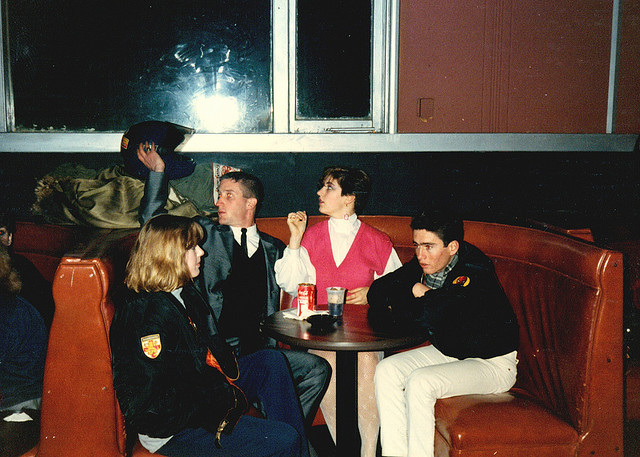
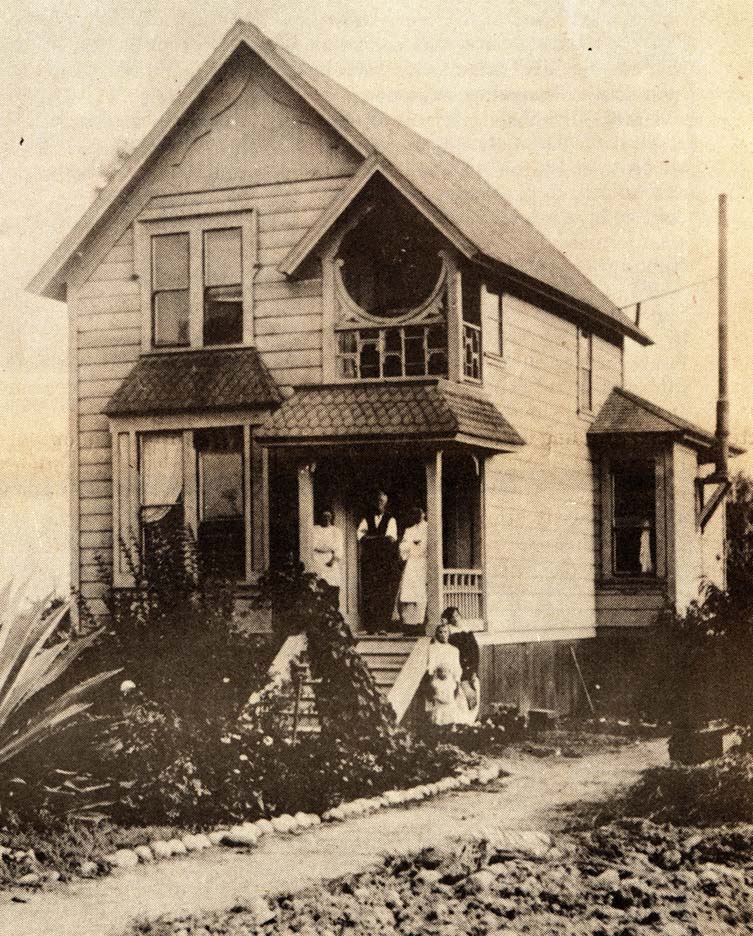
Emma’s House
3701 El Cajon Boulevard
In 1903, Emma Schnug was born in a little Victorian house that is now situated in the 3700 block of El Cajon Boulevard. The house is historically preserved with the identical façade and paint color. Although Emma has passed away, her memories of the boulevard remain.
In the early 1900s, El Cajon Avenue, which didn’t become a boulevard until 1937, was just a “wagon trail” according to Emma. To get home from downtown her parents walked two miles from Park Boulevard, the closest streetcar stop. By 1909, the streetcar company had a line running out University Avenue to their neighborhood, which made the walk home a lot shorter.
In an interview with Emma, she clearly expressed that although she has fond memories of the past, such as “no crime, no income tax, the air and water were pure, and people were friendly.” She appreciated the evolution of modern technology. To her, kerosene lamps were no comparison to the implementation of electricity.

S & S Candy – 1936
3711 El Cajon Boulevard
At the 1933 Chicago World’s Fair, Dominick Selerno and step-son Earl F. Smith of S & S Candy were set-up inside the German Village, selling a delicious range of handmade chocolates, including what they believe to be the first ever chocolate pretzels. Over the course of this festive year, Earl met his future wife, Mary Maxine Oswald Smith, who was serving beer in the beer hall. Once the fair came to an end, S & S Candy picked up their supplies and moved to San Diego to showcase their company at the 1935 Panama Exposition in Balboa Park. With their early success, along with San Diego’s undeniable perfect weather, they decided not to return to Chicago, and instead opened up a shop just one year later at 3711 El Cajon Ave.
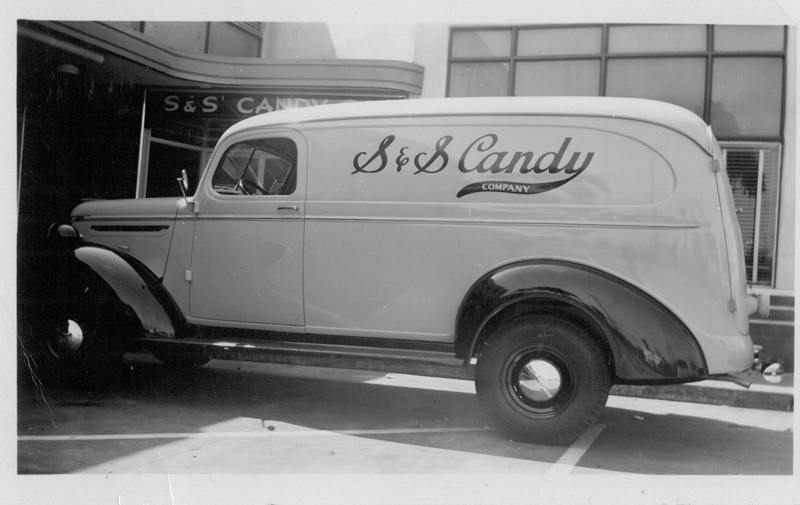
They soon became wholesalers for Knott’s Berry Farm and other big outlets, generating large quantities of fine chocolates, their noted candy apples, peanut brittle, popcorn balls and roasted nuts. Holiday specialties, such as hand formed candy canes, personalized Easter eggs, long stemmed Irish candy pipes for St. Patrick’s Day were well received by customers. Earl and Mary’s two daughters, Norene and Nancy have fond memories of working in the shop in preparation for the big holiday orders.
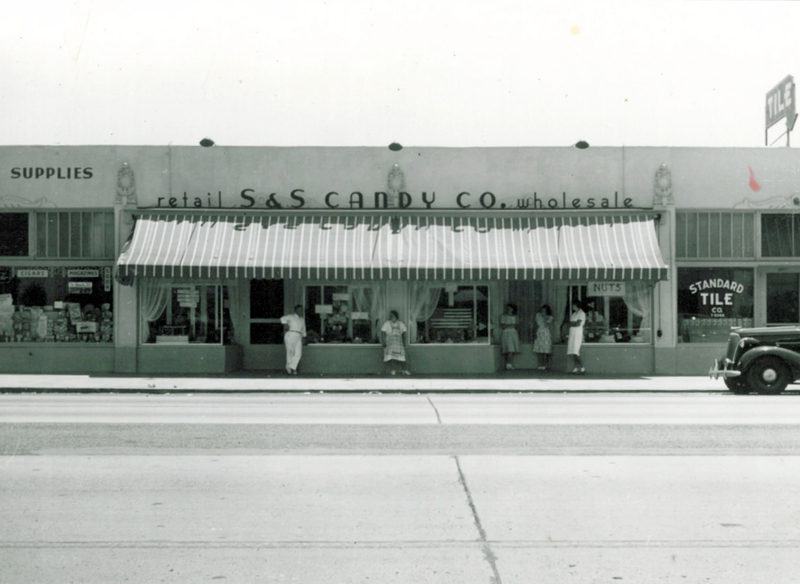
As the business flourished, in 1940 they were in need of a larger outlet to meet their demands, and soon opened up shop on Park and El Cajon Boulevard and then later across the street from Hoover High School, at 4487 El Cajon Boulevard. At this location, the family installed an animated neon sign on the roof of this location, which showed a candy maker and caramel candies moving from a candy caldron to a box. It was one of the highlights of the era, amongst the other great neon signs on The Boulevard.
When WWII hit, the US began rationing supplies, so there was a shortage of sugar. As a well-established business, S & S Candy pursued a deal with the Navy. They received a contract with them for candy and were able to keep their business up and running during the war years even with sugar rations in effect. Norene and Nancy, who still carry the legacy of their family’s business, are very proud of the company’s ability to contract with such large agencies as the Navy, and serve the country during the war.
When Norene and Nancy’s father was diagnosed with MS, the business closed down soon thereafter. The recipes were sold to Knott’s Berry Farm along with some personalized training. Unfortunately, the children only played a support role in the company, and never took part in learning the process of making chocolate nor maintaining records of company recipes. Still, the legacy of S & S Candy Co is present, passed along through treasured stories of a family-owned business, working together in the candy shop, supporting the community and building a foundation in San Diego, which remains a historical element of The Boulevard’s economic development.
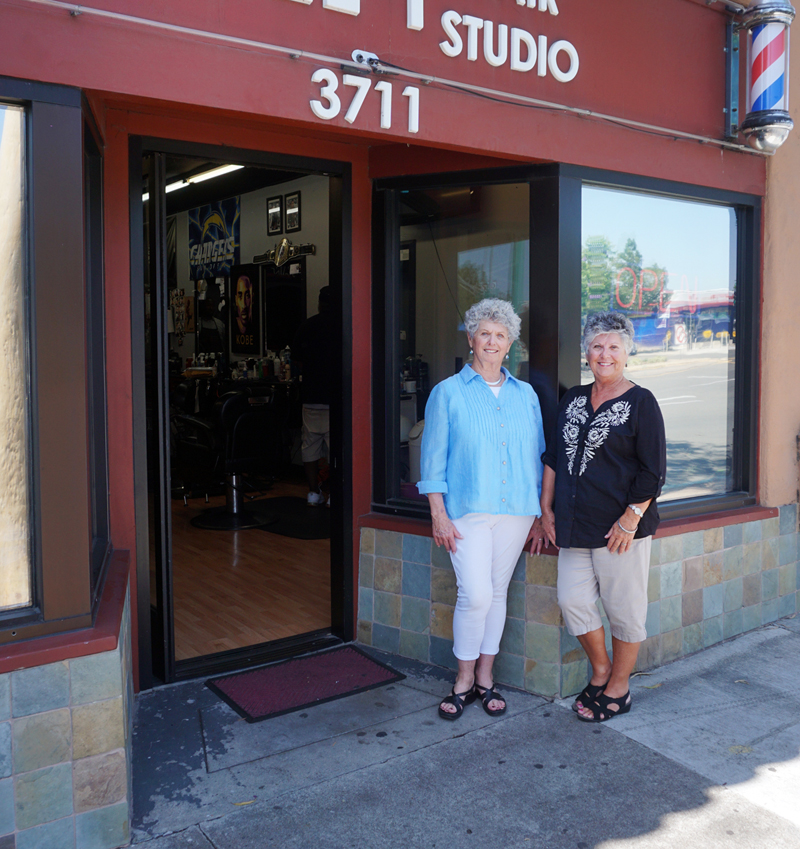
In 2016 Norene and Nancy shared the story of their family’s business and posed at the original shop located at 3711 El Cajon Boulevard. This is just two doors down from The ECBBIA office.
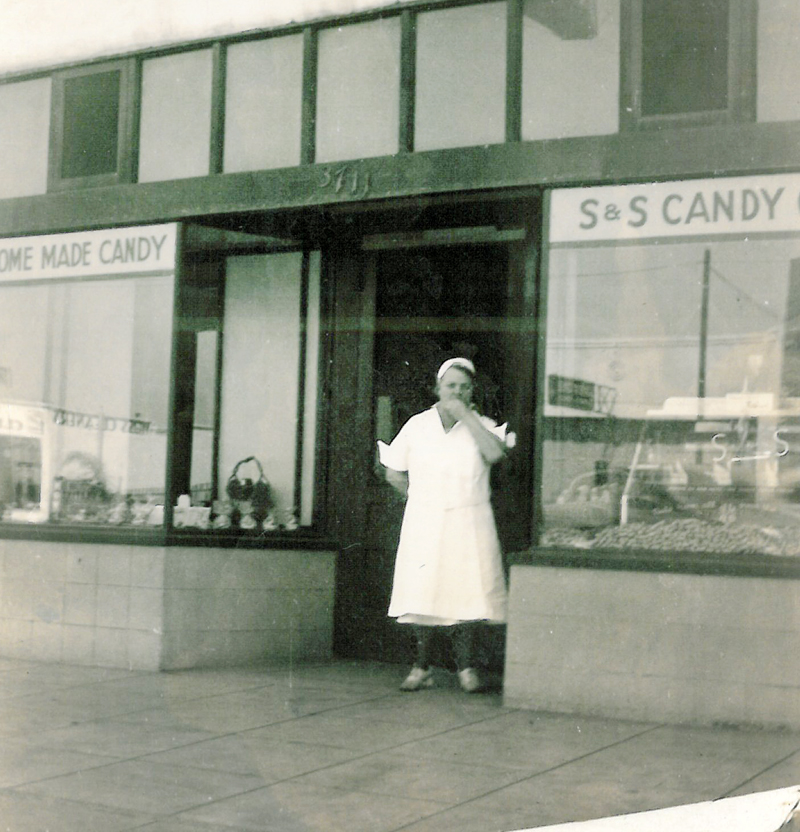
The same storefront in 1937
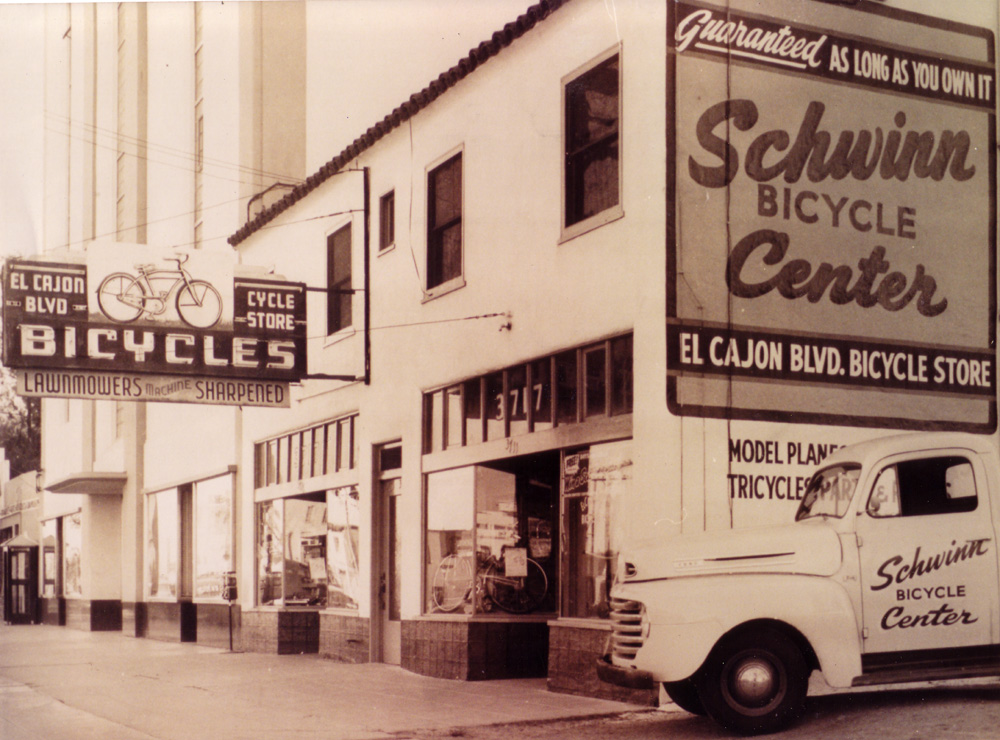
El Cajon Blvd Cycle Store
3717 El Cajon Boulevard
The S & S Candy storefront then became a Schwinn bicycle shop.

Guaranty Chevrolet
4102 El Cajon Boulevard
Louis H. Kornik was the owner of Guaranty Chevrolet. The dealership started in the 1940s. The business had locations on University and also a neighboring lot at 4050 El Cajon Boulevard. Below, sailors are seen in the showroom in 1958.
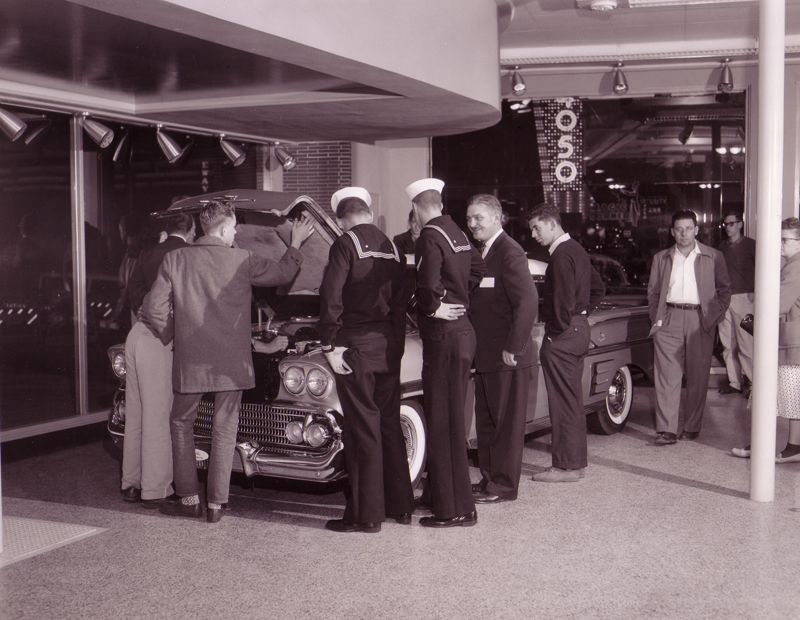

Lloyd’s Furniture
4275 El Cajon Boulevard
The Lloyd’s Furniture building was built by Melhorn Construction circa 1948.
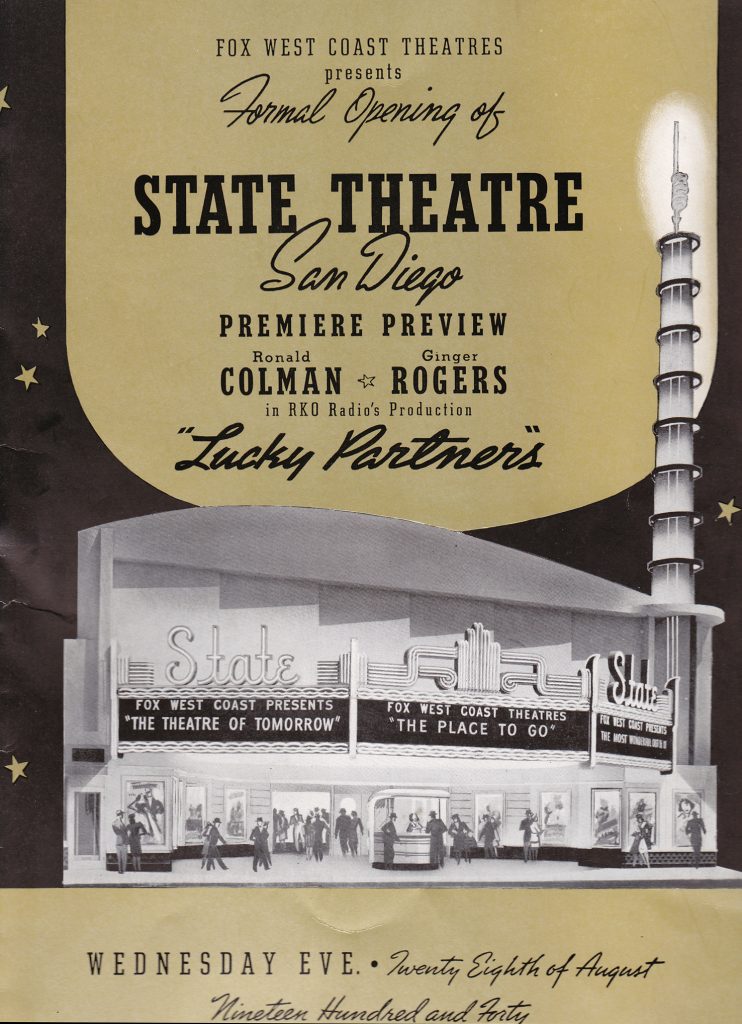
State Theater
4712 El Cajon Boulevard
The State Theater opened August 28th, 1940 as a state-of-the-art facility. The building was designed by architect S. Charles Lee. The 125 foot spire was the tallest in San Diego at the time and the flashing multicolored beacon could be seen for 5 miles. It was the first building interior completely illuminated by black light. The marquee was the largest in Southern California and used 946 letters in 64,050 square feet of neon illuminated area. It was touted as the most original architecture ever attempted outside a World’s Fair- Facts from the opening day brochure, donated to the Boulevard BIA by Moreta Cyphert.
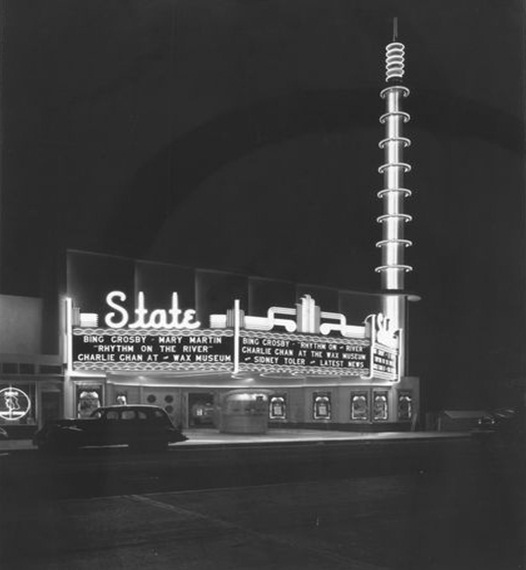
On December 6, 1935, Moreta Cyphert caravanned with a team of used cars from Dallas, Texas to Los Angeles to visit her brother in San Diego. From the moment she stepped foot in California, it seems that everything fell right into place. Before she knew it, Moreta worked her way up to being the first female manager of the State Theatre, the ultimate Motion Picture Theatre, which opened on El Cajon Boulevard in 1940.
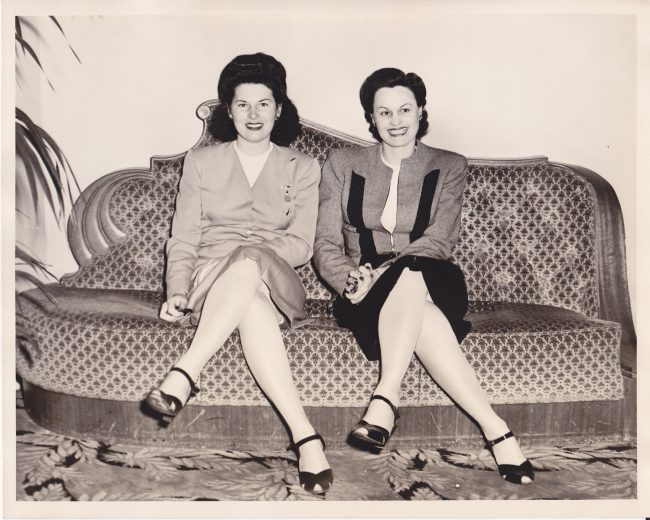
Moreta arrived with nothing but a cardboard box filled with her most important possessions. At the train station in Los Angeles, a wealthy old woman in a car with a chauffeur offered her a ride towards San Diego and then another man in a convertible drove her the rest of the way. She remembers arriving in San Diego so sun burnt that her brother hardly recognized her.
In those days, only men were hired to work in theaters, so when Moreta spotted this groundbreaking advertisement in the paper that the Fox West Coast Theatres were hiring usherettes, she decided to give it a shot. Her brother drove her to the North Park Theatre where they were holding the interviews, and when they pulled up, there was a line of beautiful women wrapped around the block.
Once she finally sat down for her interview, Moreta was asked whether she had experience. Moreta knew that if she said no, she would not get hired. Moreta remembers that the man interviewing her never looked up, until and she said, “Yes, at the Savoy Theatre in Sherman, Texas,” and she scored herself the job.
Moreta was first assigned to the Orpheum, a beautiful theatre that was located downtown on 5th and B Street. Soon enough she was promoted to the box office and then it wasn’t long before she was transferred to the Adams Theatre. An article was printed in the paper announcing Moreta’s promotion, “Usherette to Manager.” Moreta was put in charge of hiring staff for all the branches. It was at this theater on Adams Avenue that a second floor apartment was built just for Moreta, rent free. This theater is still in existence today, but is now a fabric supply store.

After a few years at the Adams Theater, the manager of the State Theatre was sent overseas, and again Moreta was granted the first female manager, but this time with the State Theatre. Moreta remembers opening nights because she had a special spot in the theatre where she sat to check the sound. In those days children paid 10 cents for a ticket and adults paid 25 cents. Her customers always wondered why the popcorn was served hot at the State Theater and nowhere else. It’s because Moreta kept the popcorn in a hot oven upstairs before the theater opened.

Moreta has fond memories of the theater’s neighboring businesses, including Oscar’s Drive-in, located on the southeast corner of Euclid and El Cajon Boulevard. Right next door to the theatre was a bar and restaurant called Til Two where the Beauty Bar is now located. Mike, the man who owned this bar, took an immediate liking to Moreta and it wasn’t long before they got married. Mike encouraged Moreta to stop working, so after her many years with the Fox West Coast Theatre company, Moreta left. At the age of 94, Moreta still carries with her great memories of working in the theatre industry in the height of her independence during an evolutionary period for women in the working world.
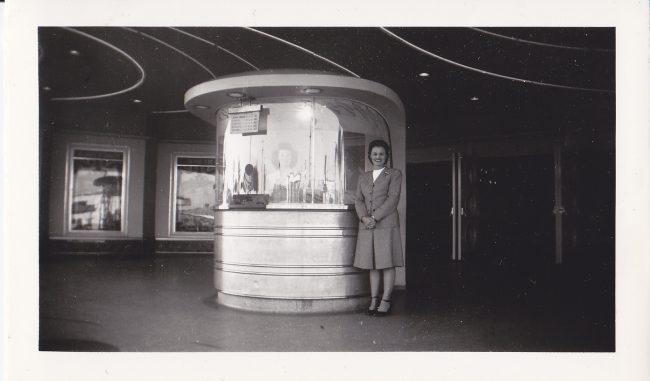
From Cinema Treasures: Built for and operated by Fox West Coast Theatres, the State Theatre opened on August 28, 1940 with Ronald Colman and Ginger Rogers in “Lucky Partners”. The State Theatre had beautiful murals adorning this sumptuous theatre’s auditorium walls, decorated by M. Chavalas, they were illuminated by ‘black light’. All seating was on a single level. Its exterior featured a 100 foot tall tower with with circular discs illuminated by neon tubing.
First operated by Fox West Coast Theatres, it was later taken over by Mann Theatres who closed the State Theatre in December 1979. In October 1980 it was taken over by an independent operator and began screening Asian movies having been renamed Trieu Thanh Theatre.
Building owners Marie Ogden and Peggy Lou Foster, daughters of the theater’s builder, sold it in June 1980 to a group of investors, Alcer Incorporated, for $425,000.00

Under Thoat Tang Minh (age 20!) and his partner Nguyen Huu Due, it reopened as the Trieu Thanh Theater on October 4, 1980. A thousand patrons attended on opening night, according to an article in the San Diego Reader dated 10-23-80. The duo also ran Asian cinemas in Anaheim, Santa Ana, Oakland, San Jose,and Sacramento.
The State Theater was demolished in 1987. The only thing the community was able to save was the terrazzo flooring that once graced this beautiful venue.

The State Theater marquee, along with other numerous neon signs that were on The Boulevard, can be seen in this 1978 News 8 throwback video.
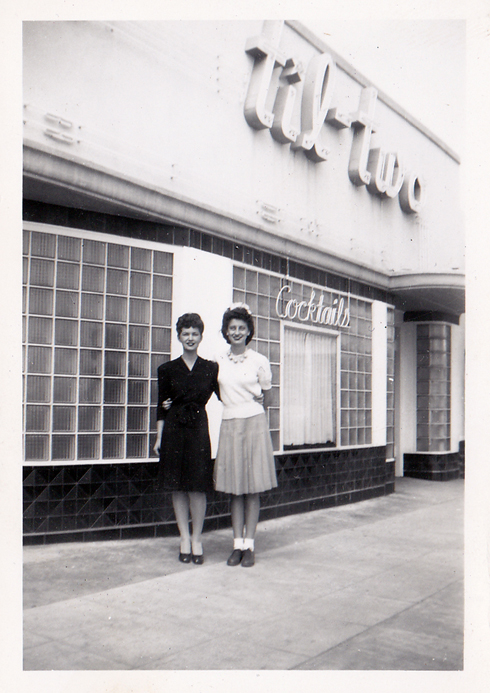
Til Two Club
4746 El Cajon Boulevard
Til Two Club was established in 1942 as a piano bar and steakhouse. Throughout the years there have been many versions of the club from The Playhouse to the Beauty Bar (2007) and in 2010, returning to the original name Til Two Club.
Til Two Club fosters the history of the bar while curating a rock n roll atmosphere with killer bands, bartenders and patrons.
More information: http://www.tiltwoclub.com/
